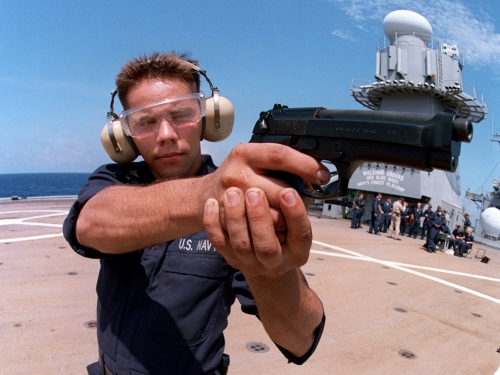
This article was originally published by SIPRI on 23 October 2014. It was published as part of a collaborative partnership between SIPRI and Economists for Peace and Security (EPS).The complete report can be accessed here.
Since the turn of the century, and in large part due to the commendable efforts of the Small Arms Survey in Geneva, we have learned much about small arms, including handheld firearms. We now know much more about firearm users, firearm misuse, the consequences of firearm misuse, complementary products such as ammunition, and legal and illicit firearm supply routes and networks. Nonetheless, relatively little is known about the firearm industry itself—that is, its manufacturers.
We can count the number of manufacturers, list the names of companies and group them by their location, but we know less about the internal workings of the industry. For example, we do not know much about innovation, costs, revenues, profitability, ownership, and labor forces, nor about the incentive structure within the industry across different countries.
Data are the foundation of evidence-based analysis and policy debate. In May 2014 the Small Arms Data Observatory (SADO) was established in order to help make progress in regard to firearm-related data. SADO is a global research consortium initially consisting of researchers living in Brazil, Norway, Spain, Thailand and the United States. Presently focusing only on the Americas, SADO’s objectives are to host and widely disseminate data sets related to the manufacture, trade, (mis)use, and effects of small arms. Researchers worldwide are welcome to join the consortium by submitting data sets or working papers.
As the authors of SADO’s first working paper, we examine the relation between variations in US state firearm laws and the number of manufacturing premises per state in the period 1986–2010. From three different sources, we coded state firearm laws into a variety of rubrics, such as laws related to the intent to impede illicit trade, impose state licensing requirements, or limit sales of certain types of firearms. For the same years, we also hand-coded data from the US Bureau of Alcohol, Tobacco, Firearms and Explosive (ATF) on the street-level location of over 2700 federally licensed firearm manufacturers. These data sets will be made public shortly. In our statistical models, we also introduced variables related to private- and public-sector activity per state as well as for crime against persons or property.
As might be expected—although no one seems to have statistically tested this before—US states with laws that might be interpreted as ‘lax’ host more firearm manufacturing premises than states with more ‘strict’ firearm laws. Law matters. This is exactly what the industry itself claims: ‘strong-law’ states push manufacturers across state boundaries to ‘weak-law’ states, generally out of the north-east of the country (e.g. Connecticut, New York) to the south-east (e.g. the Carolinas) and the south-west (e.g. Arizona, Texas). Between 2013 and mid-2014, for example, prominent firearm makers such as Beretta, Kahr Arms, Remington and Ruger all announced partial movement of their operations to (or expansions in) ‘weak-law’ states. The industry then ties such actions to political and media campaigns, in order to lobby ‘strong-law’ state legislators to moderate the laws—in part, supposedly, to ‘save’ home-state jobs and mollify firearm-owning voters.
This article was originally published by SIPRI on 23 October 2014.
However, our statistical analysis also finds that, in addition to law, the private and public sector economic variables—such as the degree of unionization (a proxy for labor cost) and state tax revenues (a proxy for public-sector monetary demands on the private sector)—matter as well. Indeed, when reading the local, ‘weak-law’ state press, invariably it is not ‘weak law’ alone but the degree of state relocation incentives offered that influence firearm manufacturers’ decisions on whether or not it is economically worthwhile to relocate from one state to another. Incentives matter, and law is merely one of these incentives. In this regard, at least, firearm makers are just like any other industry.
Establishing as a matter of fact whether or not firearm makers are just like any other industry is important because it may then permit researchers and policymakers to properly consider incentive-based and evidence-based policies in regard to the manufacture, trade, and (mis)use of firearms, in the USA or elsewhere.
While we are a long way from limiting or preventing firearm-based intrastate violent conflict, whether in Colombia or Iraq or Ukraine, a better understanding of the evidence pertaining to and the incentives governing the firearm industry itself will be an important element in thinking about to how make the world a somewhat safer, better place to live.
Jurgen Brauer, Hull College of Business, Georgia Regents University, Augusta, GA, USA and EBA Program, Department of Economics, Chulalongkorn University, Bangkok, Thailand.
Daniel Montolio and Elisa Trujillo, Faculty of Economics and Business and Barcelona Institute of Economics (IEB), University of Barcelona, Barcelona, Spain
For more information on issues and events that shape our world, please visit ISN Security Watch or browse our resources.

